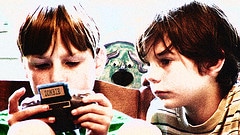
How many have you have complained about the amount of time your boys play video games?
I have, and so has nearly every other parent of boys I know. We complain about the number of hours our boys spend glued to screens, and yet…I’m beginning to think that we’re a big part of the problem.
I’m reading an interesting duo of books back to back right now: Savage Park, by Amy Fusselman, and the soon-to-be-released How to Raise a Wild Child, by Scott D. Sampson (aka Dr. Scott from Dinosaur Train). Both books convincingly make the point that children need space, time and freedom to explore, to learn and to discover their own capacities and strengths. Sadly, both books also point out the fact that space, time and freedom are in short supply for today’s youth.
Today, more than ever before in the course of human history, kids are confined inside the majority of the day. Their days are carefully scripted. Most kids in developed countries spend time in institutional childcare settings from nearly the time of birth; play time, nap time and eating time are determined by the needs of the institution, not the whims of individual kids’ stomachs or internal clocks. When kids enter school, often at the age of three or four, the regimentation continues. Preschools and kindergartens are increasingly academic, with more time devoted to letters and numbers than to free play. Free play is nearly non-existent in most elementary schools; recess has been cut or eliminated in many, and the schools that have retained recess have enacted such strict rules controlling student activity that those few minutes can hardly be called “free play.” By the time kids are in middle school, recess is all but eliminated.
Kids’ after-school and weekend hours are filled with pre-scheduled, adult-guided activities as well: Dance class. Baseball. Karate. Soccer. Mandarin class. Cooking class. 4-H. Boy Scouts. Religious classes.
And truth be told, most of us run pretty strict households as well. We may not allow balls in the house. Our kids might not be allowed to go to the park alone, or to climb trees or light fires. In today’s risk-adverse society, very few parents are allowing their children the opportunity to try anything truly risky.
Children are born with an innate need to explore and test boundaries, but we thwart those desires at nearly every turn. Almost from the time they are born, the spoken (and unspoken) message our kids receive today is: Sit here. Be quiet. Don’t do anything unless you’re told to.
The only place most of our kids experience true freedom and autonomy today is in video games.
In video games, kids are in control. They can do whatever they want. They’re free to take risks. And for the most part, it’s a world uninhabited by adults. (Yes, it’s true that many adults play video games, but most of us are not playing the games that our children are.)
In the past, Sampson writes in How to Raise a Wild Child, most children discovered their own secret and wild places – places they could explore, could go to think, could make their own. These private wild places were places kids could test their own abilities and learn about themselves. In many ways, these places were places kids could go to gradually develop their sense of self.
Most kids today don’t have access to a wild place. We’ve restricted their physical freedom to the point that most kids are not allowed more than a few yards away from home base. Adult supervision is nearly constant and adult rules reign supreme.
Given that this is reality for most of our kids, is it any wonder that so many of them spend so much time in virtual worlds? Virtual reality has become the only place our kids are safe from our intervention (so long as they ignore our pleas to Turn that off! – a feat most of them seem to have mastered).
Perhaps one of the answers to our kids’ screen addiction is to offer them more freedom here in the real world. Perhaps if we allowed our kids to explore and take risks here in the real world, the virtual world wouldn’t be nearly as attractive.
Of course, that’s easier said than done. We’re products of our world too, and many of us won’t feel comfortable letting an eight-year-old start a fire or use a saw, for instance.
Please don’t let your fear get in the way of your child’s development, though. Take a breath. Think back. Children have been building and maintaining fires and assisting adults with hunting and gathering and home making activities for millennia. Children are capable of managing some pretty complex maneuvers and responsibilities, with adult guidance.
So instead of saying no, look for ways to say yes. Look for ways to expand your child’s boundaries and capabilities. Let him try things that are beyond his current ability level. Say yes to climbing trees and splashing in creeks and biking down the big hill. Say yes to a trek into the woods alone, if at all possible. Allow your child to test his abilities and gradually expand his world.
I realize that reality poses some pretty formidable obstacles. A Maryland couple is currently under investigation because they allowed their children to walk to a park unattended. And Chicago teen Demario Bailey died earlier this year after his mother finally granted his request to walk to basketball practice.
You know your kids and your neighborhood far better than I do. I trust you to make the decisions that are best for your kids and family, given your situation. But at the same time, instead of simply bemoaning kids’ disappearance into the virtual world, I challenge each and every one of you to work towards making the real world a viable opportunity for our kids. Let’s work to once again make the real world an attractive alternative, a place where kids can play, explore, test boundaries and bond.






4 Responses
Jennifer, I loved your stance on “looking for ways to say yes”. We try to establish reasonable limits in screen time for our kids, but I tell you, anytime we can just get the kids out and about and into nature, the peace that results is undeniable. And I think you have video game “addiction” diagnosed, why kids go there. Great read today.
Thanks for your comment, Jonathan! There’s actually a quote from another parent in How to Raise a Wild Child, that essentially says what you said — when the kids are out in nature, there’s more peace; the bickering that existed in the house goes away.
I’m pretty sure my boys have found ways to fight and argue even in nature, but they’re definitely more engaged in a woods or at a river than they are in many other places.
Anyone interested in this topic should read the iconic book The Continuum Concept: In Search Of Happiness Lost
by Jean Liedloff.
Thanks for the book recommendation, Julie. I’m going to check it out.